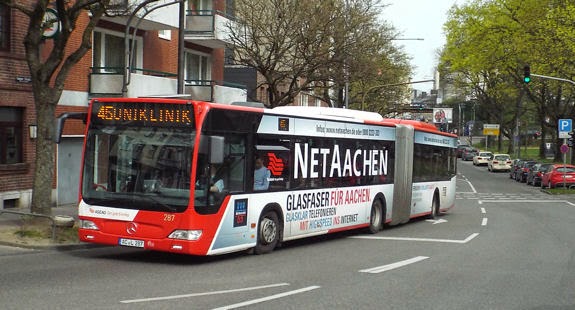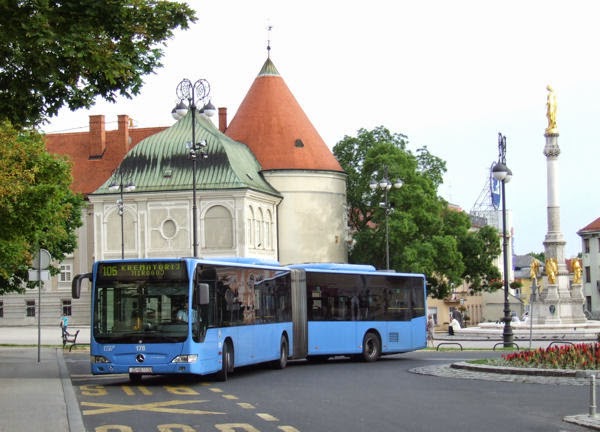Updated 28th February 2015
Are articulated buses are suitable for use in my home city, London? Or anywhere else in the United Kingdom, for that matter? This is a topic which has been hotly debated in some circles.
I started this blog in 2012, partly to create an online resource to which I could refer when debating on e-mail and internet forums.
Are articulated buses are suitable for use in my home city, London? Or anywhere else in the United Kingdom, for that matter? This is a topic which has been hotly debated in some circles.
I started this blog in 2012, partly to create an online resource to which I could refer when debating on e-mail and internet forums.
Articulated buses were introduced to London from Summer 2002. By 2006, they were operating twelve of London's busiest routes, running at high frequencies. Following a change of Mayor, however, the articulated buses were progressively withdrawn from service. The last one ran in December 2011. They were generally replaced with double-deckers, but double-deckers carry fewer passengers. Frequencies were increased in most cases, requiring more buses and raising costs although, in many cases, overall capacity was still lost. Pay more, get less. An unusual policy.
One oft-voiced criticism of articulated buses was that, while they were OK in mainland Europe where they operated on "wide continental boulevards", they were unsuited to London (or other UK cities) where city streets are narrower and more twisting. Or so it was alleged.
I'm going to put this to the test. What does a "wide continental boulevard" look like?
This one, in the centre of Munich, is a good example, no?
OK, maybe that one is a bit extreme. And I will concede that it is definitely "continental", so it does achieve one of the three.
Here are plenty more examples of articulated buses operating on what are probably best described as "city streets", rather than "wide continental boulevards". OK, I guess these are continental city streets. Where do I start?
 From Aachen...
From Aachen...
... to Zagreb.
 From Scandinavia in the north, where articulated buses operate in cities such as Trondheim (right) or Malmö (below),...
From Scandinavia in the north, where articulated buses operate in cities such as Trondheim (right) or Malmö (below),...
...to the Iberian peninsula in the south, such as in the Spanish city of San Sebastián,...
From Brussels, the seat of the European Union...
... and around roundabouts, such as this one in Köln.
 ...but some cities are also home to articulated trolleybuses, such as Budapest (left) and Geneva (below).
...but some cities are also home to articulated trolleybuses, such as Budapest (left) and Geneva (below). If articulated buses really are more suited to "wide continental boulevards", how do they cope with temporary road restrictions?
If articulated buses really are more suited to "wide continental boulevards", how do they cope with temporary road restrictions?
Quite well, it would appear, if these examples in Budapest (left) and Bordeaux (below) are anything to go by.
 Do articulated buses have to stick to busier roads, even? Take a look at these examples and decide for yourself.
Do articulated buses have to stick to busier roads, even? Take a look at these examples and decide for yourself.
...Luxembourg,...
...Munich,...
...Vienna,...
...and Hamburg.
 Hamburg doesn't stop at articulated buses. It is one of several European cities where I have found bi-articulated vehicles.
Hamburg doesn't stop at articulated buses. It is one of several European cities where I have found bi-articulated vehicles.
Do these vehicles, nearly 25 metres in length, confine themselves to "wide, continental boulevards"? The image to the left suggests not.
But surely I didn't find them in the same narrow street, about to take the same tight corner, as the articulated bus in the above image?
Yes I did!
Another charge levelled against articulated buses is the danger they (allegedly) pose to cyclists. One reason for removing them from London's streets was it was claimed they had caused may cyclists to be killed. In fact, it later emerged that the number of cyclists killed in London in collisions with articulated buses was... none.
Here in Hamburg, articulated buses and cyclists appear to be co-existing happily.
 In the Netherlands, a country where the number of journeys made by bicycle is high, articulated buses can also be found.
In the Netherlands, a country where the number of journeys made by bicycle is high, articulated buses can also be found.
Utrecht is one of a number of Dutch cities where articulated buses operate.
And is that street really a "wide, continental boulevard"?
You will find articulated buses in part-pedestrianised shopping areas, such as in Wuppertal,...
Articulated buses are quite at home on narrow streets in older cities, too, such as Salzburg...
...or Ljubljana.
 Articulated buses can also be found on the streets of smaller towns. These examples are in Dachau,...
Articulated buses can also be found on the streets of smaller towns. These examples are in Dachau,...
...Baden-Baden,...
...Vaals, on the Dutch-German border (although the bus is from Belgium),...
 ...and Baarle-Nassau on the Dutch-Belgian border (these images are quite literally on the border!)....
...and Baarle-Nassau on the Dutch-Belgian border (these images are quite literally on the border!)....
Articulated buses operate in more rural settings too.
This one is leaving Buchs, in Switzerland's St. Gallen canton, heading into Liechtenstein.
These are just examples, from some of the places I have visited over recent years. But maybe I should look beyond continental Europe. Are things any different over on the other side of the Atlantic?
 New York is in some ways a newer city than many of its European counterparts. Manhattan's road network is a grid, with wide Avenues running on a north-south axis crosses by streets running east-west.
New York is in some ways a newer city than many of its European counterparts. Manhattan's road network is a grid, with wide Avenues running on a north-south axis crosses by streets running east-west.The streets do appear less wide, however once you reach Lower Manhattan. This doesn't appear to pose a problem for articulated buses.
 Vancouver, in western Canada, is another relatively new city having been founded in the late 19th Century. Like New York, the street pattern is based on a grid. Yet are all the streets "wide boulevards"?
Vancouver, in western Canada, is another relatively new city having been founded in the late 19th Century. Like New York, the street pattern is based on a grid. Yet are all the streets "wide boulevards"?I will finish on the streets of London - London, Ontario, that is. When I visited, there was not a double-decker to be seen anywhere on London's streets. But there were articulated buses.
Does this look like a "wide boulevard" to you?










































No comments:
Post a Comment